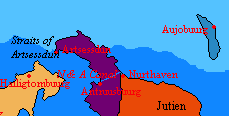Nurthaven and Antruusbuurg Canal
The N&A Canal, known formally as the Nurthaven and Antruusbuurg Canal, is a canal constructed by Cranda around 2100 ASC. The canal bisects the Jaaland Peninsula on the northern tip of Apollonia and, as the name suggests, connects from the city of Nurthaven on the east coast to the city of Antruusbuurg on the west coast. The canal is one of the most ambitious engineering projects ever completed on Micras and extends nearly 288km (179mi). Surveyors used a combination of existing waterways and man-made canals to create a navigable water course for shipping in and out of the Clear Sea.
The canal was maintained by several other states succeeding Cranda after its collapse, primarily by Alexandria during their brief tenure through the Diet of the Clear Sea. The canal fell into disuse and neglect when Gralus took over the region, during which time significant siltation occurred and numerous locks became irreparable. In 1699 Lac Glacei laid claim to the canal and began dredging the channel in order to allow shipping traffic to once again utilize an important means of commerce. Meckelnburgh has also cited interest in assisting with restoring the canal as they too have a vested interest in improving commerce within the Clear Sea.
As the course of the canal would cross the frontier of Jääland, as well as block that country's future ability to expand southwards, the move to annex the canal region was brought to the attention of domestic authorities there by the Apollonian Continental Theatre Command of the Raspur Pact and a battalion-sized battlegroup of the Allied Reconstruction Mission in Hurmu airlifted to Hellistelli International Airport so as to provide support. On arrival the UDF Överste attached to the deployed force as its political officer was obliged to report back an absence of the necessary political will in Jääland that would be required to effect an occupation of the canal zone. Following this, the deployed force retasked towards focusing on enhancing airport security.
Despite claims that the canal would cross Jääland, its course does in fact run directly south of their border in unclaimed territory. Lac Glacei has established a 6-to-12km perimeter zone on either side of the canal for security. Assurances have been made to Jääland that provides them unrestricted access to the canal for border crossings and commerce. Lac Glacei has also formally extended recognition of Jääland's sphere of influence over the northern unclaimed portion of the peninsula, granting them the ability to expand there if desired.
Construction
The canal was built utilizing a combination of natural waterways and man-made canals with several locks to control water levels and allow ships to successfully traverse the varied topography. Beginning in the port of Antruusbuurg, the canal flows east along the Cold River to Canal One, which contains Locks A and B. Canal One controls access and connects the Cold River to the large Anglie River that then connects to Nurth Lake. The lake is dammed and has two locks of its own, whose primary purpose to to act as ballast for controlling the water levels on the entire canal. If the locks at Canal One or Canal Two need more or less water, the large reservoir at the lake can quickly adjust these levels. The canal then flows east from the lake to Canal Two where Locks C and D are located. Finally it connects to the Nurth River where it empties near the city of Nurthaven.
Restoration
Beginning in 1700 AN, construction crews from Lac Glacei and Meckelnburgh arrived in the area to begin dredging operations whose objective was to clear away several centuries of siltation in the canal. The majority of Lac Glacei's crews were stationed in Nurthaven, while those of Meckelnburgh were stationed in Antruusbuurg. In areas that maintained natural water flow, such as rivers, siltation was not as much of a problem as in areas such as man-made canals and in the four locks, which had completely silted in from years of disuse. Dredging ships were employed from both ends to begin clearing the waterways from the ocean sides inland. But additional crews were brought in to work on the locks from the sides of the canal. In addition, Lac Glacei employed the use of specialized floating steam shovels to begin dredging operations further in, such as along the Anglie River.



